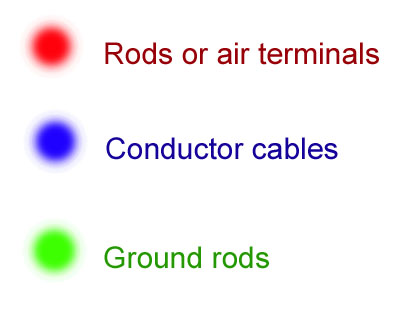In a normal weather, there is an electrical field at the surface of Earth. This electrical field is about 100 to 150V/m worth. Indeed, Earth atcs like a condensator with a good insulator : the low parts of the atmosphere, the tropopause, situated between 2 conductors, the ground and the inonosphere.
The ionosphere is the higher part of the atmosphere, not very dense, in which the atmosphere’s ionization by the bombardment of particles or by the radiation( UV or X-rays coming from the sun, cosmic radiation, etc …) is the most important. Indeed there are 2 phenomenons in the atmosphere: ionizations (particularly in the higher parts of the atmosphere ) and ions losses, caused by the phenomenon of ions recombinations(the less dense the atmosphere is, the less important these recombinations are). These 2 phenomenons balanced in the ionosphere and so a large number of ions are present in that zone of the atmosphere : then this zone is conductive. The ionosphere is globally neutral where as the ground is naturally neagtivly charged, wich explains the permanent presence of the magnetic field at the surface of Earth.
The atmosphere is not a perfect insulator because there is a slight outflow current between the ground and the ionosphere. This current would end up discharging the ground if there wouldn’t have been mechanisms to reload it, like storm.

 Fire– Fire can start anywhere the exposed lightning channel contacts, penetrates or comes near flammable material (wood, paper, gas pipes, etc) in a building – including structural lumber or insulation inside walls and roofs. When lightning follows electrical wiring, it will often overheat or even vaporize the wires, creating a fire hazard anywhere along affected circuits.
Fire– Fire can start anywhere the exposed lightning channel contacts, penetrates or comes near flammable material (wood, paper, gas pipes, etc) in a building – including structural lumber or insulation inside walls and roofs. When lightning follows electrical wiring, it will often overheat or even vaporize the wires, creating a fire hazard anywhere along affected circuits. Side flashes – Side flashes can jump across rooms, possibly injuring anyone who happens to be in the way. They can also ignite materials such as a gasoline in a garage.
Side flashes – Side flashes can jump across rooms, possibly injuring anyone who happens to be in the way. They can also ignite materials such as a gasoline in a garage. Damage to building materials – The explosive shock wave created by a lightning discharge can blow out sections of walls, fragment concrete and plaster, and shatter nearby glass.
Damage to building materials – The explosive shock wave created by a lightning discharge can blow out sections of walls, fragment concrete and plaster, and shatter nearby glass. Damage to electrical appliances – Televisions, microwaves, phones, washers, lamps and just about anything plugged into an affected circuit may be damaged beyond repair. Electronic devices and computers are especially vulnerable.
Damage to electrical appliances – Televisions, microwaves, phones, washers, lamps and just about anything plugged into an affected circuit may be damaged beyond repair. Electronic devices and computers are especially vulnerable.


